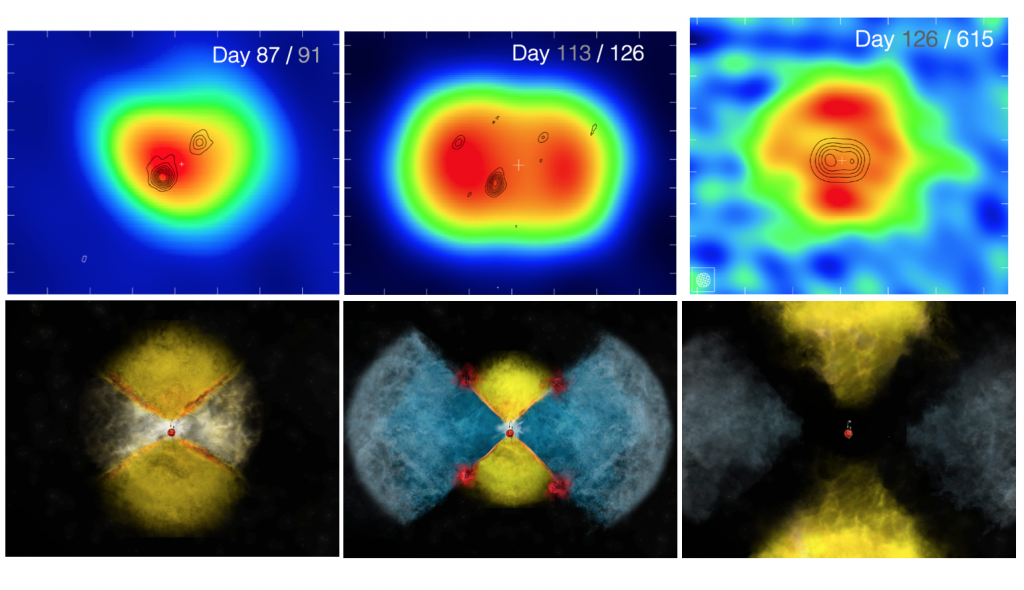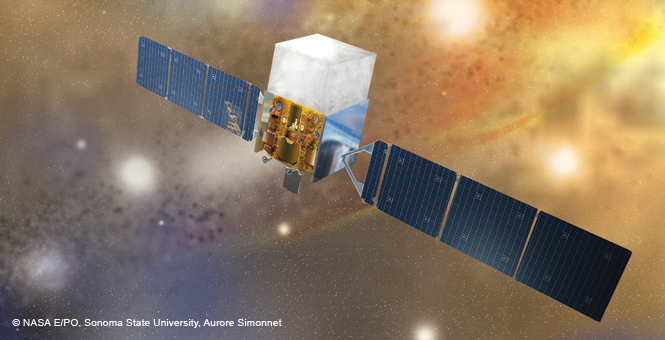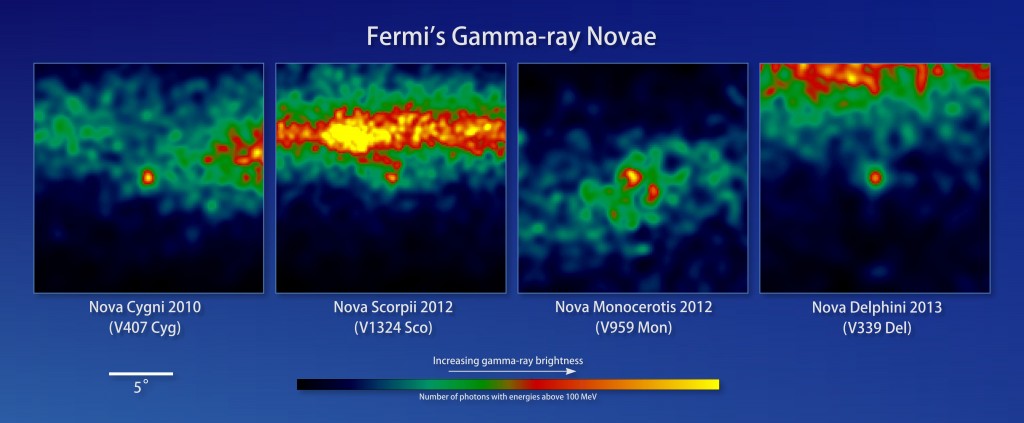A “Noval” Mystery
- By Maggie Masetti
- November 10, 2014
- Comments Off on A “Noval” Mystery
The mystery around Nova V959 Mon was recently deciphered with the use of multiwavelength light – including radio, X-ray, and gamma-ray.
First off, what is a nova? It’s basically a huge thermonuclear explosion that’s caused when a dense white dwarf star pulls material from an orbiting companion star onto itself. The resulting blast spews gaseous debris outward.
And what’s the mystery around V959 Mon? Well, in 2012, astronomers using the Fermi Gamma-ray Space Telescope noticed that V959 Mon gave off gamma-rays, which was a new and surprising development in the study of novae. Also now astronomers had to figure out the mechanism by which this occurred.
Fortunately, there were radio observations made at the same time with the Karl G. Jansky Very Large Array (VLA), as well as later ones by the Very Long Baseline Array (VLBA) and the European VLBI network. The VLA data indicated that there were subatomic particles moving nearly at the speed of light, that were interacting with the magnetic field in the shock front. Both radio and gamma-ray emission requires such fast-moving particles – so by locating the site of one, we can locate the other. The later VLBI observations show two “distinct knots of radio emission,” which were moving away from each other.
Adding all these together with more VLA observations in 2014 and UK observations made with e-MERLIN, finally provided scientists with the needed information for piecing this together.
What is happening is this. The white dwarf star, which is the nuclear ash of a star like the sun, pulls matter – fresh fuel – from its companion star to itself. When enough fuel accumulates after thousands of years, the surface layer detonates in a thermonuclear explosion. This seems to throw off the envelope preferentially in the orbital plane of the binary. Later, the white dwarf blows off a wind of particles, and this wind moves even faster than the material the star initially threw off. When this faster flow of particles hits the slower moving material, it creates a shock, which accelerates the particles to the speeds necessary to produce gamma-rays and the knots of radio emission.
Says Laura Chomiuk, Michigan State University researcher, “We not only found where the gamma-rays came from, but also got a look at a previously-unseen scenario that may be common in other nova explosions.”
And indeed, since the 2012 outburst of V959 Mon, the Fermi telescope has detected gamma-rays from three additional nova explosions.
We got the chance to interview Laura Chomiuk to ask her more about her research on this nova and about the scientific questions that surrounded it.
NASA Blueshift: Tell us a little bit about yourself! How did you get into working on novae?
Laura Chomiuk: I’ve just started my second year as a professor at Michigan State. I’m loving my job so far – working with a lot of excited and exciting students and postdocs, having the freedom to think about interesting scientific questions, and be able to take advantage of our lovely national observatories. I actually got into studying novae because of one of these lovely public observatories – the Very Large Array. After graduate school, I spent some time hanging out at the telescope, helping polish up some of its new capabilities, and a team of scientists came knocking because they wanted help observing novae with the VLA. I got so lucky that day! It had never occurred to me to study novae before, but they turned out to be so much richer and more interesting and well, weirder, than I could have dreamed!
NASA Blueshift: Could you explain your research in a nutshell?
Laura Chomiuk: Novae are supposed to be these relatively low-energy, garden variety explosions that we understand really well, but they keep throwing surprises at us. The most recent surprise was that they appear to emit really high energy light with gamma-ray wavelengths, as detected by NASA’s Fermi Gamma-Ray Telescope. Gamma-ray sources are rare in our galaxy, and nobody expected gamma-rays from novae, because gamma-rays are typically produced in really fast, violent shocks, and novae weren’t supposed to have such energetic blasts. Our team was able to zoom in one of these gamma-ray producing novae and take really detailed images using a bunch of radio telescopes. These pictures showed the expansion of the nova explosion and also showed how the nova could produce gamma-rays. We found that the nova explosion isn’t at all spherical like a ball, but instead it is elongated like an hourglass. The fast moving material in the hourglass plows into really dense, slow-moving stuff that hangs out at the waist of the hourglass, and this interaction gives you the violent shocks needed for gamma-ray production.

A nova does not explode like an expanding ball, but instead throws out gas in different directions at different times and different speeds. When this gas inevitably crashes together, it produces shocks and high-energy gamma-ray photons. The complex explosion and gas collisions in nova V959 Mon is illustrated above. In the first days of the nova explosion, dense relatively slow-moving material is expelled along the binary star system’s equator (yellow material in bottom left panel). Over the next several weeks, fast winds pick up and are blown off the binary, but they are funneled along the binary star system’s poles (blue material in bottom central panel). The equatorial and polar material crashes together at their intersection, producing shocks and gamma-ray emission (red regions in central panel). Finally, at later times, the nova stops blowing a wind, and the material drifts off into space, the fireworks finished (in bottom right panel). Our [artist conception] images, in the top row, illustrate these phases. In the top left panel, the color image shows the bulk of the nova ejecta, as imaged by e-MERLIN. Around that time, the shocks were imaged with the EVN array, and showed the locations of shocks and gamma-ray production (shown here as black contours, tracing synchrotron emission). The center panel shows similar components one month later, when the shocked knots have expanded and a third component has become visible. At late times (color image in the top right panel), the brightest, densest material is now oriented differently, corresponding to the slower moving equatorial material.
Credit: L. Chomiuk, B. Saxton, NRAO/AUI/NSF
NASA Blueshift: What are novae? What do scientists hope to learn about them?
Laura Chomiuk: Novae are the most common nuclear explosions in the Universe. They happen when a white dwarf star (which is a compact core left over when a star like our Sun dies) has a nearby companion star, and the white dwarf manages to pull gas off its companion star. The gas on the white dwarf collects and grows in pressure over time, until nuclear fusion explosively turns on. Then all that collected gas gets blown off into space at speeds of thousands of miles per second—that is the nova! After the nova, the whole process can actually repeat. The white dwarf will start to pull gas from its companion star again, and will likely host another nova sometime in the future—it could be 10 years, or a million years.
I’m really interested in novae because there is still so much we don’t understand about them. They are supposed to be relatively simple, common explosions, but they show all this surprising behavior—the strange hourglass geometry and strong shocks in our recent paper are just one example. For example, a nova is supposed to be a single nuclear explosion, but novae often look like they have multiple outbursts in rapid succession, and continue to expel material for sometimes months after the initial explosion. Ultimately, I would like to understand how much mass and energy are released by nova explosions, and the physics that determines this release. But first we have to wade through a lot of strange and complicated behaviors!
NASA Blueshift: What is V959 Mon? What does its name mean? What made it the right candidate for these observations, compared to other systems?
Laura Chomiuk: V959 Mon was the subject of our paper. It was one of the first novae detected in gamma-rays, and turns out to be a really nice, nearby novae to study. The fact that it is unusually nearby [6500 light years away] was convenient, because it meant the nova was brighter than usual, and allowed for higher-quality images. I wish every nova would be as well-behaved as V959 Mon.
The name V959 Mon is typical of how we name variable stars. The ‘V’ stands for variable, meaning that its brightness changes with time. It was the 959th variable star discovered in the constellation Monoceros (a Monoceros is apparently a unicorn, not a rhinoceros as I had been believing until I just googled it).
NASA Blueshift: How do different wavelengths of light help you understand nova explosions? In particular, how do radio observations help you understand gamma-ray emissions when they’re at opposite ends of the electromagnetic spectrum?
Laura Chomiuk: Each wavelength regime gives unique insights into the complex explosions of novae, and in the case of radio and gamma-ray wavelengths, these insights are very complimentary. Violent shocks in astronomical explosions can accelerate particles to near the speed of light, creating so called ‘cosmic rays’. It is the interaction of these cosmic rays with their surroundings that produces gamma-rays and radio emission. So in the case of V959 Mon, radio waves acted as a tracer of gamma-ray production.
NASA Blueshift: How does your collaboration work? How do you coordinate with researchers working in multiple wavelengths, especially with systems that are event-based and rapidly changing?
Laura Chomiuk: Our collaboration involves people from all over the world, and I really am proud of the number of scientists and telescopes that worked together to collect observations for V959 Mon. When it became clear that V959 Mon was an unusually interesting, nearby event, we sent out a telegram to all astronomers letting them know that we planned to observe it with one particular radio telescope, the VLA. This inspired astronomers from other parts of the U.S. and Europe to try and obtain additional data on their telescopes, and we were in regular contact about how best to cover this interesting event. To make sure that we get good coverage on a time-variable event, it’s very important to stay focused and keep the channels of communication open. We have regular telecons and email discussions, and try to meet face-to-face whenever we can!
NASA Blueshift: What makes this discovery new/interesting/useful for scientists in better understanding novae, gamma-rays, etc.? What question(s) did this help answer?
Laura Chomiuk: Astronomical sources that produce gamma-rays really are unusual and exceptionally energetic. In our Galaxy, there are only a few classes of stellar objects that produce gamma-rays: neutron star pulsars, accreting compact objects—and now novae. Novae show that a much wider range of physical conditions can result in these most energetic of photons than previously thought.
Also, our study sheds some light on how nova explosions are actually powered. Our imaging of V959 Mon is consistent with a scenario wherein the binary star system whips around inside the gaseous nova envelope, and actually transfers some of the binary orbit’s energy to the nova ejecta. This “binary eggbeater” process gives an extra kick to the explosion and shapes the nova ejecta, potentially explaining some of the complexities we see in novae.
NASA Blueshift: And, of course, what new questions did it create? What’s next?
Laura Chomiuk: Since V959 Mon, Fermi has gone on to detect gamma-rays from several more novae, implying that perhaps all novae produce these most energetic photons. However, it remains unclear if the process for producing gamma-rays we identified in V959 Mon applies to these other novae. We are continuing to observe novae at radio, optical, X-ray, and gamma-ray wavelengths to understand their complex explosions, strong shocks, and ejecta geometries.
NASA Blueshift: Thanks, Laura!
You can also read more about this novae in the press release.
There is even more to the story of course. V959 Mon also emitted X-rays – and we know people who observed them! Stay tuned for part 2 of this story where we interview former Blueshifter Tommy Nelson.





